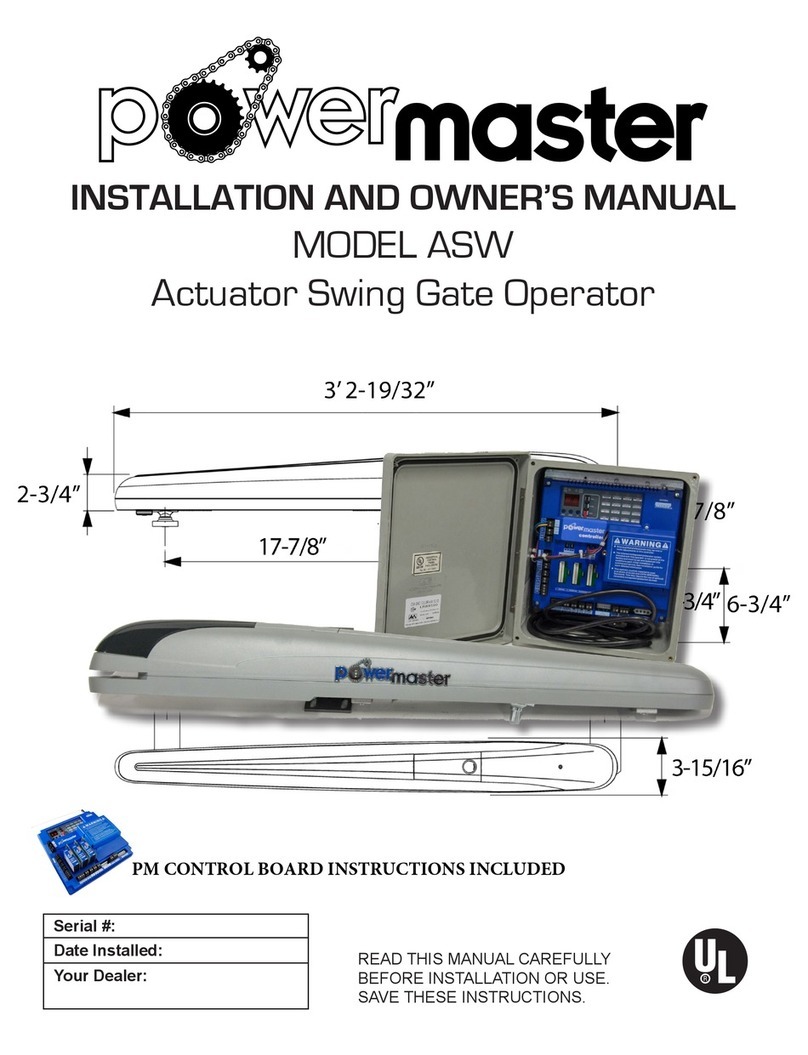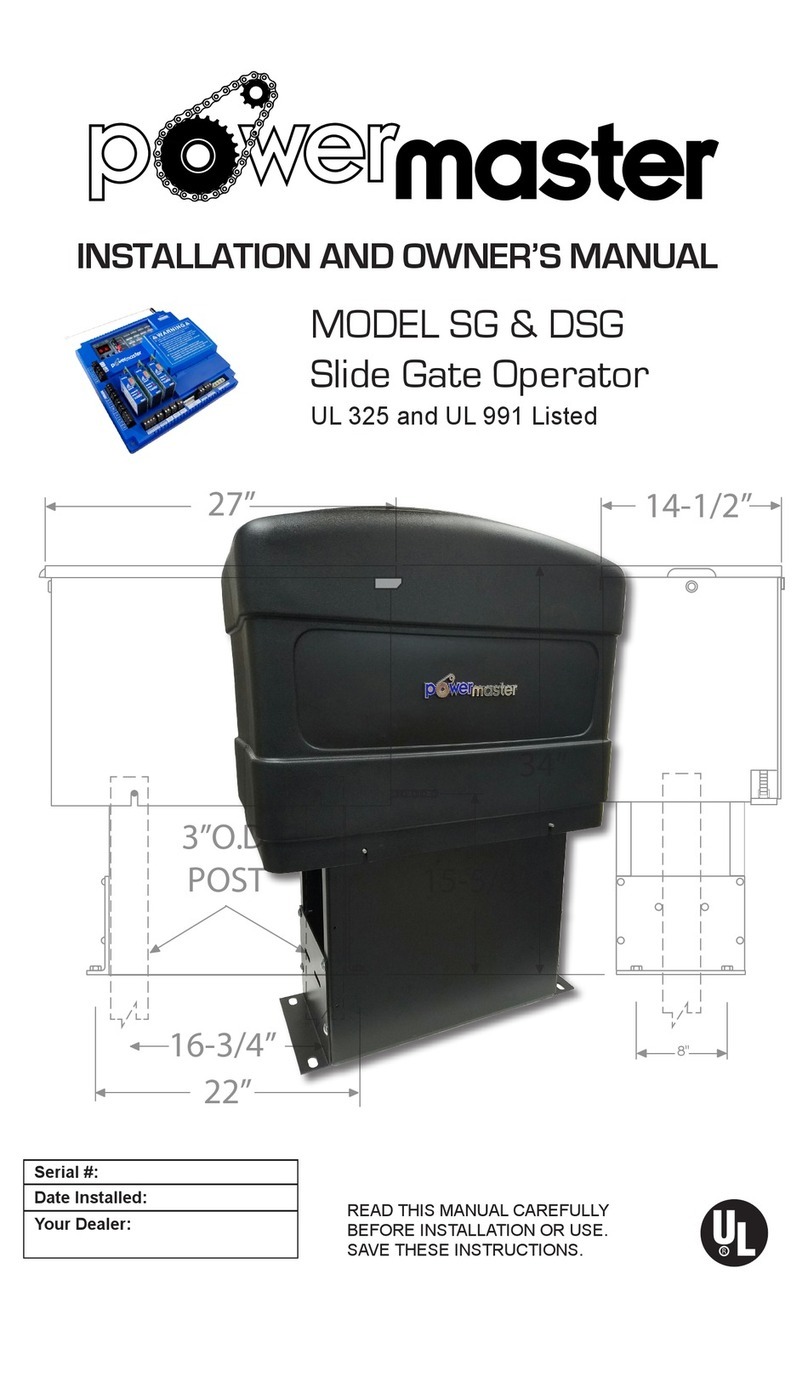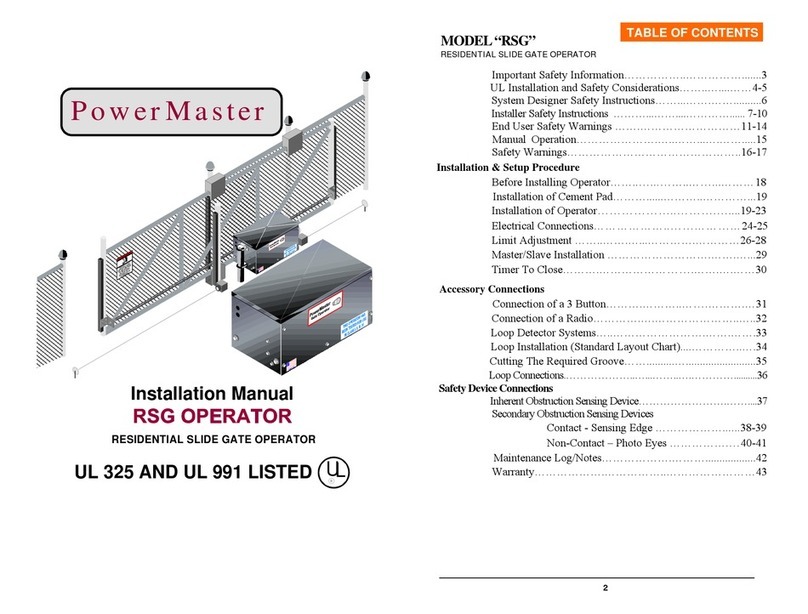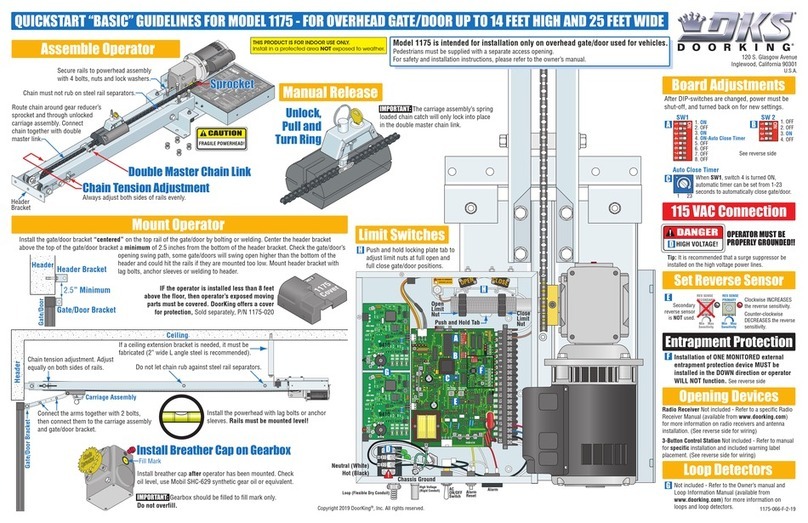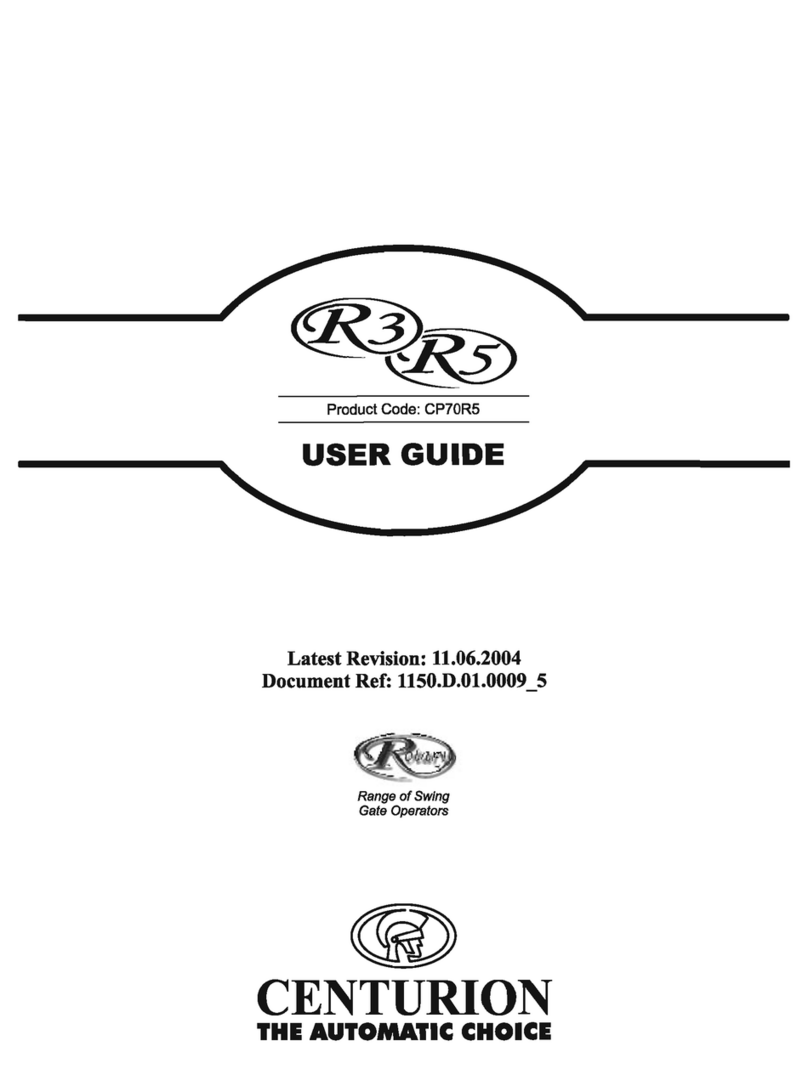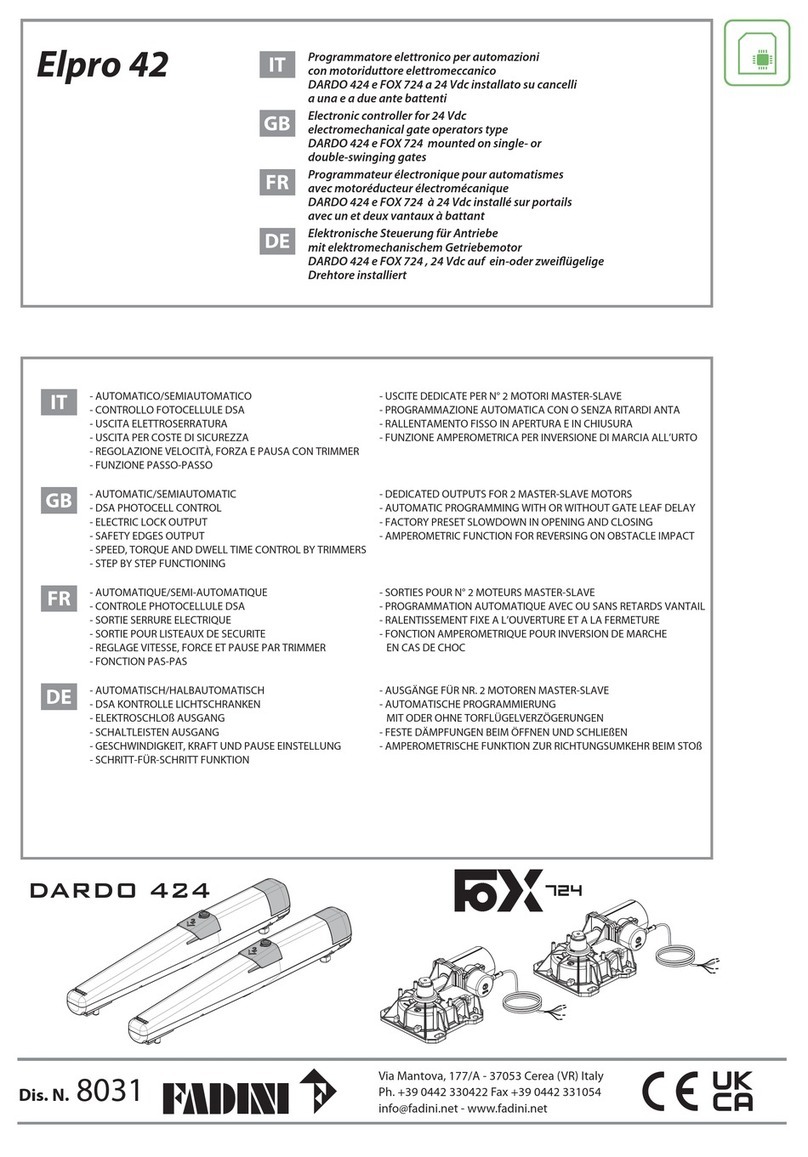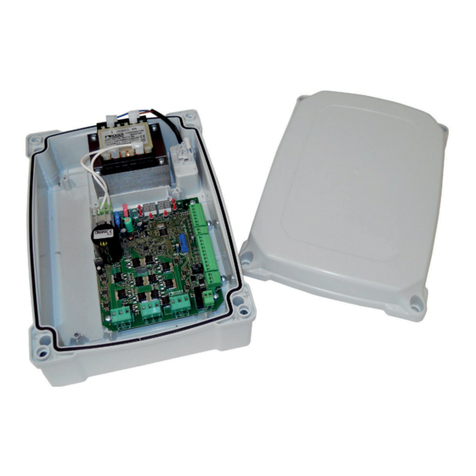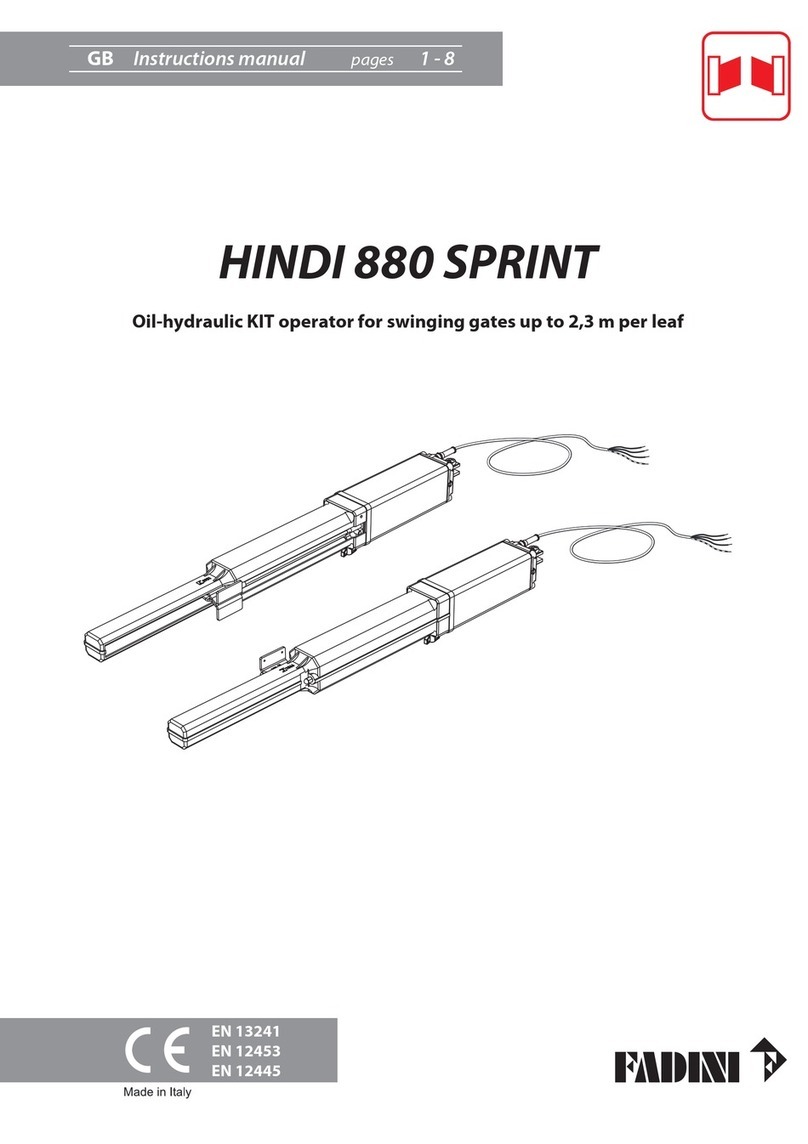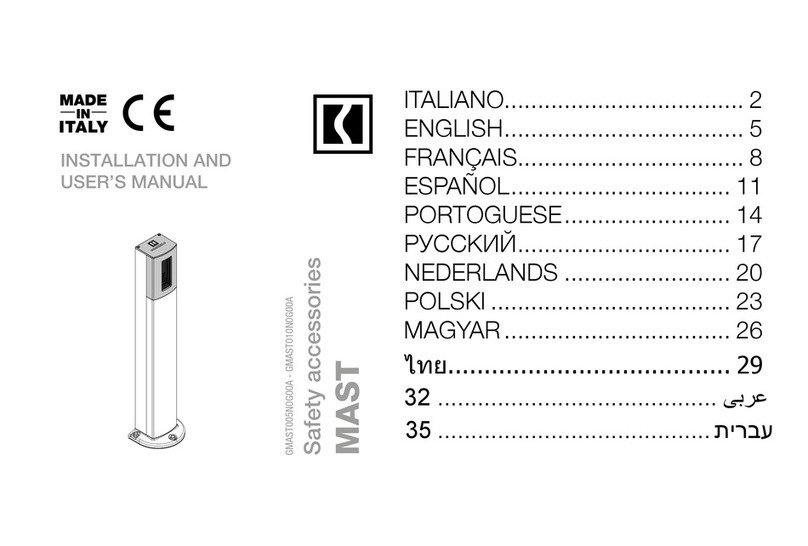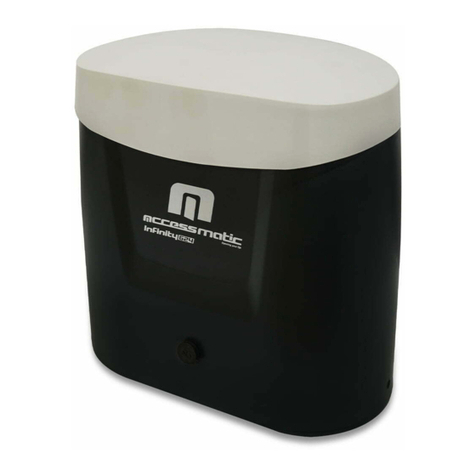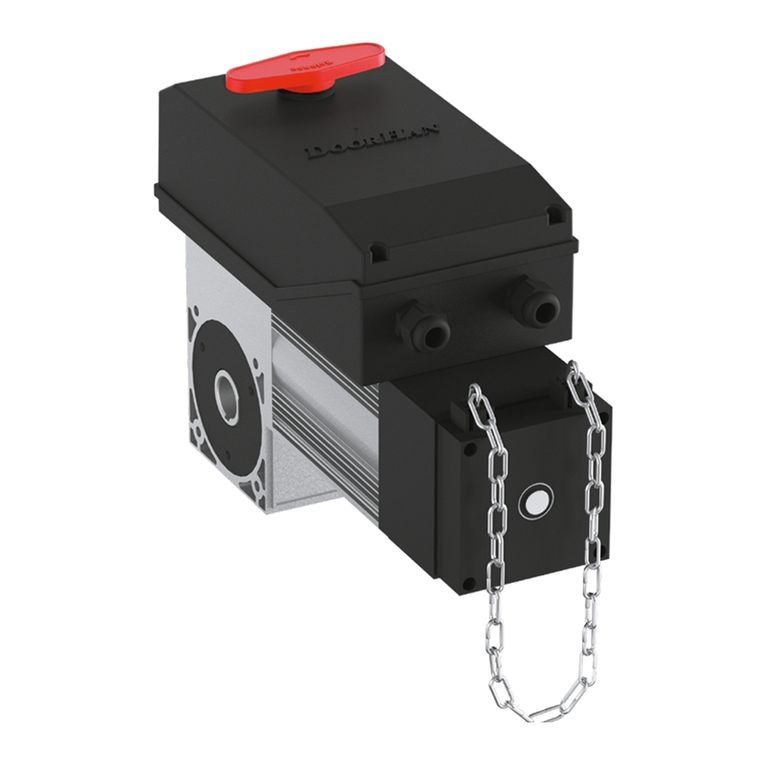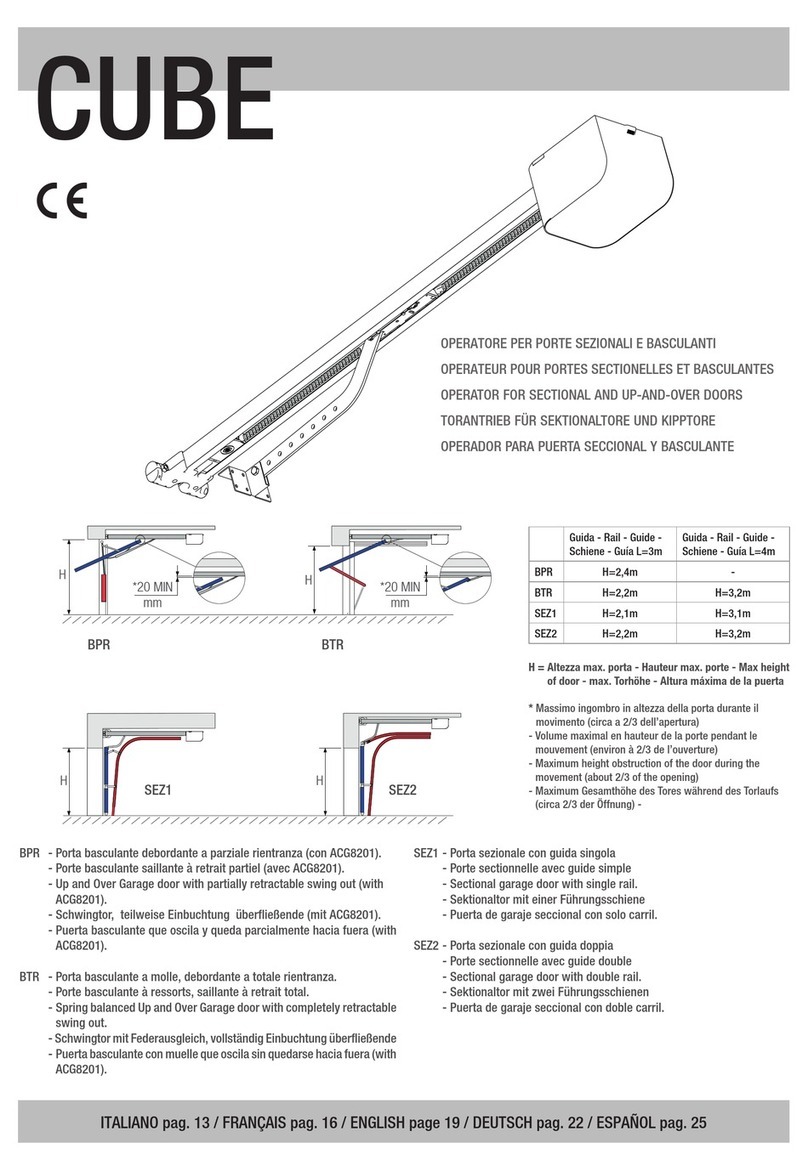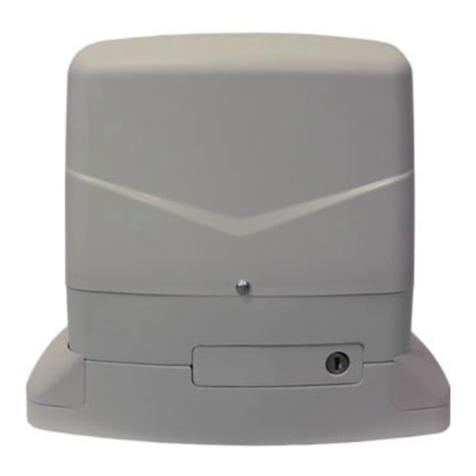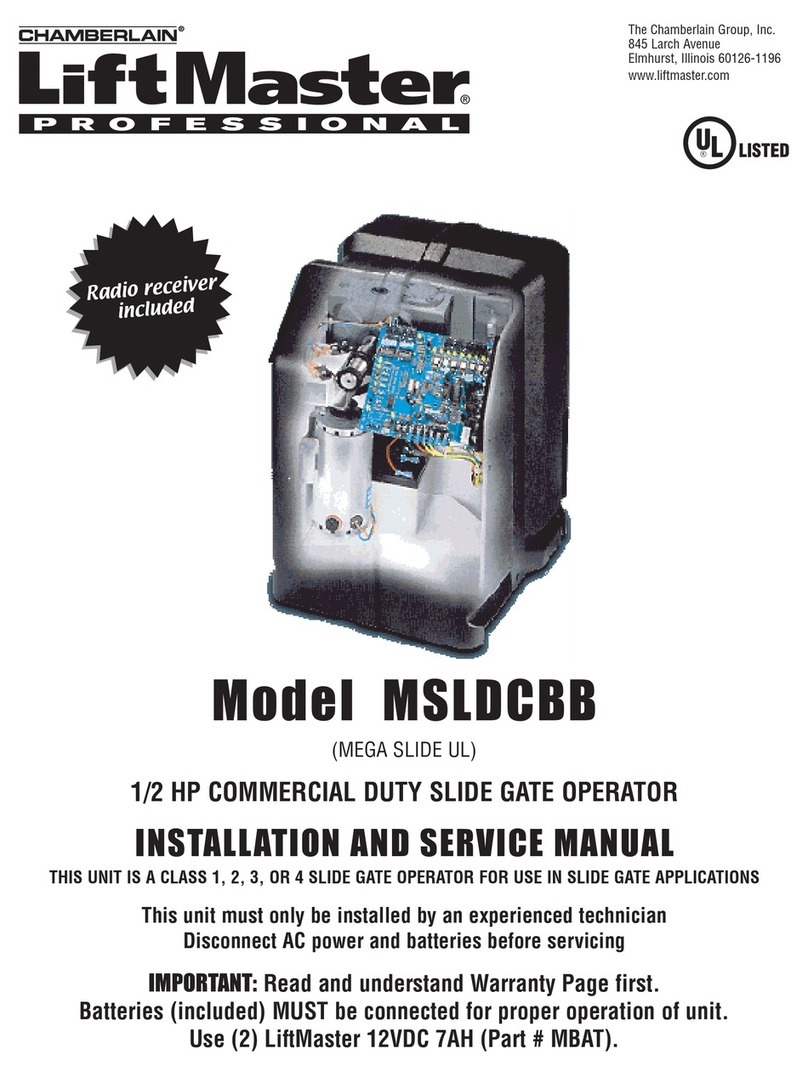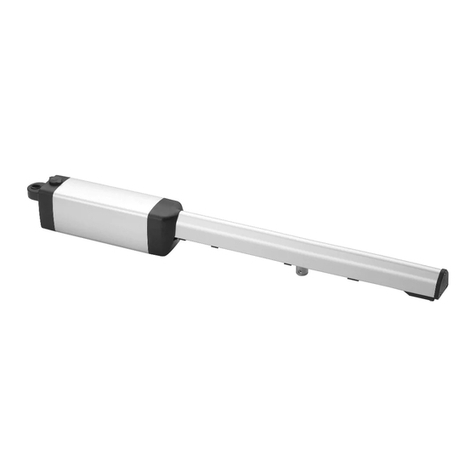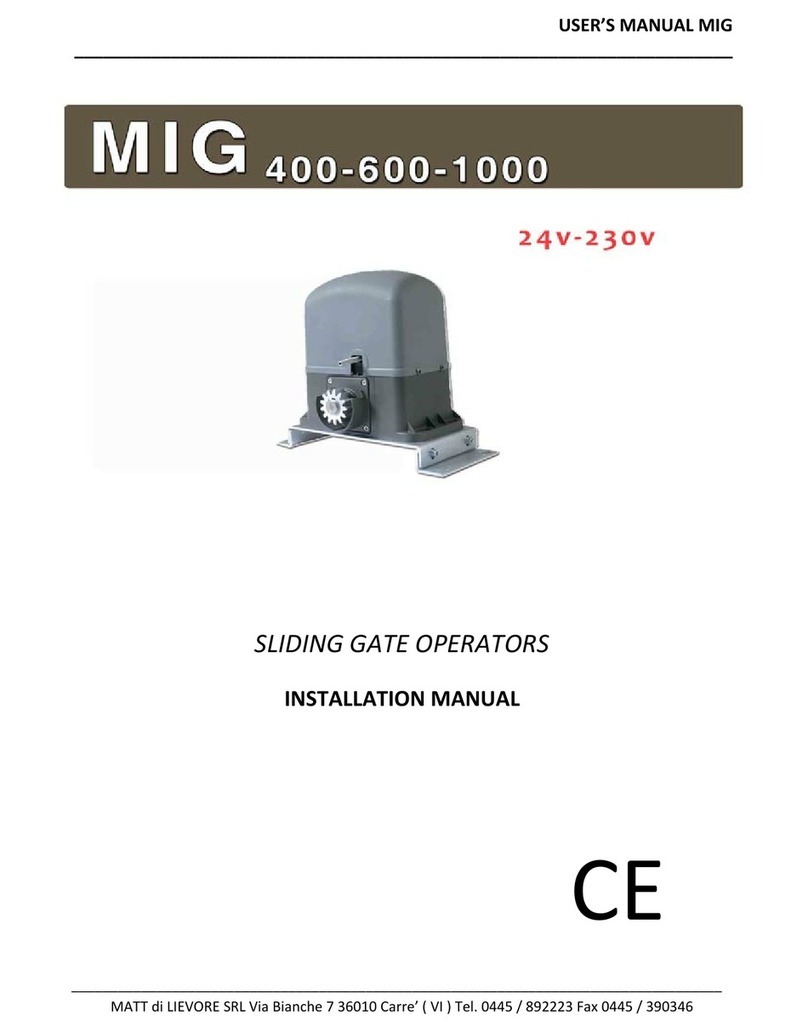Power Master SG 2004 User manual

2

3
I
I
IM
M
MP
P
PO
O
OR
R
RT
T
TA
A
AN
N
NT
T
T!
!
!
FOR SLIDE GATE OPERATING SYSTEMS
SAFETY IS EVERYONE’S BUSINESS
Automatic gate operators provide convenience and security to users.
However, because these machines can produce high levels of force, it is
important that all gate operator system designers, installers, and end
users be aware of the potential hazards associated with improperly
designed, installed, or maintained systems. Keep in mind that the gate
operator is a component part of a total gate operating system.
The following information contains various safety precautions and
warnings for the system designer, installer and end user. These
instructions provide an overview of the importance of safe design,
installation, and use.
Warnings are identified with the ▲symbol. This symbol will identify
some of the conditions that can result in serious injury or death. Take
time to carefully read and follow these precautions and other important
information provided to help ensure safe system design, installation and
use.
▲WARNING:Gate operators are only one part of a TOTAL
GATE OPERATING SYSTEM. It is the responsibility of purchaser,
designer, and installer to ensure that the total system is safe for its
intended use. All secondary entrapment safety devices must be
RECOGNIZED by U/L to ensure the safety of the complete operating
system.
4
U/LINSTALLATIONANDSAFETYCONSIDERATIONS
INSTALLATION CLASSES
CLASS I – RESIDENTIALVEHICULAR GATE OPERATOR
A vehicular gate operator (or system)
intended for use in a home of one to four
single-family dwellings, or a garage or
parking area associated therewith.
CLASS II–COMMERCIAL / GENERAL ACCESS VEHICULAR GATE OPERATOR
A vehicular gate operator (or system)
intended for use in a commercial location
or building such as a multifamily housing
unit (five or more single family units),
hotel, garages, retail store or other
building servicing the general public.
CLASS III- INDUSTRIAL/LIMITED ACCESS VEHICULAR GATE OPERATOR
A vehicular gate operator (or system)
intended for use in an industrial location or
building such as a factory or loading dock
area or other locations not intended to
service the general public.
CLASS IV- RESTRICTED ACCESS VEHICULAR GATE OPERATOR
A vehicular gate operator (or system) intended
for use in a guarded industrial location or
building such as an airport area or other
restricted access locations not servicing the
general public, in which unauthorized access is
prevented via supervision by security personnel.

5
SYSTEM DESIGNER SAFETY INSTRUCTIONS
▲1. Familiarize yourself with the precautions and warnings for the installer.
Users are relying on your design to provide a safe installation.
▲2. The operator is supplied with a primary obstruction sensing entrapment
protection system. The installation must also have a secondary
entrapment protection system installed, such as photoelectric sensors or
an electric edge system.
▲3. When designing a system that will be entered from a highway or main
thoroughfare be sure the system is placed far enough away from the road
to eliminate traffic backup. Distance from the road, size of the gate, usage
levels, and gate cycle/speed must be considered to eliminate potential
traffic hazards.
▲4. The majority of injuries from slide gate operator systems occur with Open
Roller or Ornamental Grille Type Gates. We strongly recommend the
use of roller guards. The illustrations and descriptive captions found on
the following pages provide precautions to help eliminate injuries or
fatalities. Familiarize yourself with them when designing the total system.
▲5. Design the gate system so a person cannot reach through the gate to
operate any controls. Never place controls on the gate operator itself.
6
INSTALLER SAFETY INSTRUCTIONS
BEFORE INSTALLATION
▲1. Check to see that the operator is proper for this type and size of gate
and its frequency of use. If you are not sure, consult factory.
▲2. Check to see that there are no structures adjacent to the area, which
may pose a risk of entrapment when gate is opening or closing.
▲3. You must ensure that the gate has been properly installed and works
freely in both directions. Replace or service any worn or damaged gate
hardware prior to installation. A freely moving gate will require less
force to operate and enhance the performance of the operator as well
as the safety devices used within the system.
▲4. Install the gate operator on the inside of the property and/or fence line.
DO NOT install an operator on the public side of the gate.
▲5. Severe injury or death can result from entrapment by a gate. The
operator is supplied with an obstruction sensing primary entrapment
protection system. Additional safety equipment such as electric edges
or photocell sensors must be installed to provide the required
secondary entrapment protection system. For assistance in selecting
the correct type of safety equipment, consult the factory.
▲6. Review the operation of the unit and become familiar with the manual
disconnect mechanism and safety features of the system.
▲7. You must install a pushbutton control or key switch to allow for normal
operation of the gate if the automatic controls do not work. Locate the
push button or key switch and small warning placard within sight of the
gate in a secured area at least 10 feet or more from the gate and fence
to keep users away from the moving gate and fence.
▲8. Outdoor or easily accessed gate controls should be of the security type
to prohibit unauthorized use.

7
DURING INSTALLATION
▲1. Be aware of all moving parts and avoid close proximity to any pinch points.
▲2. Disconnect power at the control panel before making any electric service
connections. Connection location for controls and safety equipment can
be found on the wiring diagram, and in this manual.
▲3. Know how to operate the manual disconnect mechanism.
▲4. Adjust the open and close force adjustment on the control board in each
direction to the minimum force required to operate the gate smoothly. DO
NOT increase the force adjustment setting to makeup for rough
spots in gate travel - FIX THE GATE INSTEAD!
▲5. Locate the controls at least 10 feet from the moving gate so that the user
can observe the gate operation, but is not able to come in contact with the
gate while operating the controls.
8
▲6. Attach large warning signs provided to each side of gate in the
most conspicuous place. Mount control station and smaller
warning placard together within sight of the gate opening.
WARNING
Moving Gate Can Cause
Serious Injury or Death.
KEEP CLEAR! Gate May Move
at Any Time. Children Should
Not Operate Gate. Operate
Gate Only When Area is in
Sight and Free of People
and Obstructions.
AFTER INSTALLATION
▲You are responsible for ensuring that the end user understands the
basic operations and safety systems of the unit, including the
location and operation of the manual disconnect.
▲Point out that the safety instructions in brochure are the
responsibility of the end user, and then LEAVE A COPY OF THIS
BROCHURE WITH THE END USER

9
END-USER SAFETY WARNINGS
The manufacturer of the gate operator does not know what type of gate you
have, or what type of automatic system is installed on your gate. Be sure you’ve
been fully instructed on the sequence of operation for your specific gate
system(s). Keep the gate properly maintained and have a qualified service
person make repairs.
▲1. Be sure the following safety instructions are distributed to all persons
authorized to use your gate.
▲2. KEEP GATEWAY CLEAR (Front and Back) AT ALL TIMES. Your
automatic gate is not for pedestrian use. No one should ever cross the
path of the moving gate.
10
▲3. DO NOT allow children to play near your gate, or to operate the gate.
▲4. DO NOT operate your gate system unless you can see it when the
gate moves.
▲5. Be sure a pushbutton or key switch has been installed for manual
electric operation in the event your radio or card does not work. Any
mounted control station should be located a minimum of 10 feet from
the gate so the gate cannot be reached through or touched. Any
pushbutton located in a building should be installed within sight of the
gate.
▲6. DO NOT operate any controls without watching the movement of the
gate.

11
▲7. If your gate has open rollers, be sure roller guards have been
purchased and installed.
INCORRECT
CORRECT
12
▲8. Your gate system is required to have a primary and a secondary
entrapment safety system installed and maintained.
▲9. If your gate closes automatically, loop detectors should be installed to
detect the presence of a vehicle.
▲10.DO NOT increase force adjustment to compensate for a damaged gate.
The gate should always be maintained to operate manually as easily as
possible to provide maximum protection.
▲11.Check all safety systems at least once per month for the correct force,
speed and sensitivity. Gate must reverse when hitting a rigid object, or when
a non-contact sensor is activated. If these functions are observed to
operate improperly, discontinue use and have it serviced immediately!
▲12.You are responsible for ensuring that warning signs are installed and
maintained on both sides of your gate.
▲13.To ensure safe operation of this equipment, you must read this safety
manual and keep it for reference.
MANUAL DISCONNECT OPERATION
▲Your operator is equipped with a pad lockable emergency disconnect for
manual operation. Be sure you have a key and understand how to operate
this equipment. To disengage operator, move red disconnect lever to the left
and latch it in place.
▲WARNING: NEVER OPERATE THE MANUAL RELEASE WHEN THE
GATE IS MOVING.
To Re-Engage Drive:
Lift Lever To Unlatch,
Then Move Lever To
The Right.
To Disconnect Drive:
Move Lever To The Left Until
It Latches In Retaining
Bracket.
Padlock
Option Hole
Retaining
Bracket
Disconnect
Lever

13
SAFETY WARNINGS FOR OPEN-ROLLER GATES
AND ORNAMENTAL GRILLE-TYPE GATES
▲WARNING: INJURIES ASSOCIATED WITH AUTOMATIC GATES ARE
MAINLY INCURRED WITH OPEN-ROLLER GATES AND
ORNAMENTAL “GRILLE TYPE” GATES
OPEN-ROLLER GATES
▲Injuries occur when people get their hands caught between the top of the
gate and the roller. This potential pinch point should be guarded
whenever an automatic operator is installed. Roller Guards are available
from various fence suppliers for refitting of these rollers.
ORNAMENTAL “GRILLE TYPE” GATES
▲Injuries occur when people put their arms through openings in the grilles
when the gate is operated. The person cannot retract his/her arm and it
gets caught between the grille and the fence post or fence. The potential
hazard must be guarded. It can be simply done by placing a screen mesh
on the gate and fence in the area of the gate. The screen must be a
minimum of 4 feet high from the bottom (unless the gate and fence are
shorter) with openings that a 2¼-inch sphere cannot fit through. This will
help to prevent access through openings when the gate travels.
4'
MINIMUM
14
INSTALLATION INSTRUCTIONS
▲WARNING: DO NOT APPLY POWER UNTIL TOLD TO DO SO! RISK
OF ELECTRICAL SHOCK OR INJURY MAY RESULT!
BEFORE INSTALLING OPERATOR
IMPORTANT: Operator should always be mounted inside the gate.
Determine whether the installation is Left hand or Right hand by the
direction the gate moves in order to open, when viewed from inside the
fence.
RIGHT HAND
PUBLIC AREA
OR STREET
LEFT HAND
PUBLIC AREA
OR STREET
1. Gate must slide freely to fully opened and fully closed position.
2. Gate and/or extension must extend beyond the position of the
operator. The operator will be located as shown above, for left and
right hand installation.

15
INSTALLATION OF CEMENT PAD
Lay out the cement pad as shown. Be sure top surface is level. Allow 2 days
cure time before installing operator. Bolt pattern must be parallel to the gate.
INSTALLATION TO PAD
1. Assemble stand and mount power head using carriage bolts.
Nut
7-1/2"
16-5/8"
22"
30"
14"
11-3/4"
9"
Fence
10-1/2"
3-3/4"
AGate
Opening
Gate
B40" Min.
Min. Gate Length = Gate Opening +A +B +40"
C
L
Of Drive Chain
Gate
Bracket 31
2
1 3" O.D. Pipe, Extending Min. 18" Above Ground
Only Required For Optional Post Mounting (2) Places.
2 1/2" Mounting Hardware (4) Places ( Not Supplied).
14" X 30"
Cement
Pad
3 Install Chain Support Bracket As Required.
16
2. Using ½” hardware (Not Supplied) bolt assembled unit to the pad,
being sure to align operator parallel to the fence.
NOTE: Sprockets must face the fence.
In Ground
Depth As Required
By Local Code
Conduit Depth
As Required
By Local Code
Cement Pad
Drive
Chain
14"
30"
FENCE

17
ATTACHING DRIVE CHAIN
1. Install gate brackets at each end of the gate with U-bolts provided. Do not
fully tighten at this time.
2. Attach a chain take up bolt to one end of the drive chain using a #50
connecting link.
3. Install spring fittings into gate brackets using ¾” nuts and lock washers.
DO NOT tighten.
4. Install chain take up bolt, previously attached to the chain, into spring
fitting in furthest gate bracket. Secure it in position with spring, spring
washer, and ½” elastic stop nut.
PowerMaster
Cement
Pad
Gate
Leading Edge Gate
Extension
Gate
Bracket Chain
Support
Bracket Drive Chain Gate
Bracket
Chain Support
Bracket
Chain Support
Back up plate
Bolt
Washer
Nut
Gate
Bracket
1/2-13 Elastic
Stop Nut
Spring
Washer
Chain
Tensioning
Spring Spring
Fitting
3/4 Internal Tooth
Lock Washer
3/4-10 Jamb Nut
Chain take-up Bolt
#50 Connecting Link
Install Chain Support
Brackets As Required
Nut
3/8"
U-Bolts
18
5. Disengage operator by moving the red disconnect lever (Located on
the operator base at the opposite end from the motor) to the
disconnect position, and latch in place.
6. Thread free end of chain under first idler sprocket, up and over drive
sprocket, then under the second idler sprocket.
NOTE: When pulling chain through operator sprockets, the limit nuts in the
electric box can be driven passed their normal position. Reset the limit
nuts as necessary.
Drive
Sprocket
Idler
sprockets
Drive
Chain
Drive
Chain
To Re-Engage Drive:
Lift Lever To Unlatch,
Then Move Lever To
The Right.
To Disconnect Drive:
Move Lever To The Left Until
It Latches In Retaining
Bracket.
Padlock
Option Hole
Retaining
Bracket
Disconnect
Lever

19
7. Pull the chain through to the opposite end of the gate. Cut the chain to the
correct length, attach remaining chain take-up bolt and install in the gate
bracket as in steps 2 through 4.
8. Adjust the gate bracket height at both ends of the gate to insure the drive
chain aligns with the operator idler sprockets.
9. Tighten the gate brackets securely and lock in position with the setscrews
provided.
PowerMaster
Gate
Bracket Chain
Support
Bracket Drive Chain Gate
Bracket
U-Bolts
Nut
Nut
Set
Screw
20
NOTE: By moving the gate manually to
each end of its travel, chain alignment
is simplified.
11.Adjust chain tension so that the chain
tension springs are reduced to a length
within 1-7/8” and 1-3/4”.
ELECTRICAL SET-UP AND CONNECTIONS
CONNECTION OF INCOMING POWER
NOTE: Wiring to operator must use watertight materials in accordance with local
electric code. See wire gauge/distance charts for proper sizing. Master/Slave
installations should have SEPARATE power supply wiring or length of wire runs
should be figured at half that shown on the chart. This unit must be grounded
in accordance with N.E.C. and local codes.
WARNING: DO NOT APPLY POWER UNTIL TOLD TO DO SO! RISK OF
SHOCK OR INJURY MAY RESULT.
NOTE: Before connecting the operator to an incoming power supply, use a
voltmeter to determine that the electrical service is the same as that on the
Adjust Spring Length
As Shown For Proper
Chain Tension
Jamb Nut

21
operator label. If the operator is connected to an incorrect power supply,
damage will result, which is NOT covered by warranty.
▲1. Be sure the power switches at source, and at the operator are OFF.
▲2. In the diagram below find the supply power that matches your installation
and connect as shown.
WIRE GAUGE
Line
voltage HP 14 AWG 12 AWG 10 AWG 8 AWG 6 AWG
1/2 150/350 250/400 400/500 500/700 650/1000
3/4 150/250 250/400 400/600 500/850
1 PH
115/
208-
230 1 150/300 250/450 400/700
1/2 450/2000 750/3000 1200/4300
3/4 350/1500 600/2400 900/3700 1100/4500
1 300/1200 450/1900 750/3000 900/4800
3 PH
208-
230
440-
480 1 1/2 200/800 400/1500 500/2000 900/4800
BLK BLK
BLK BLK
BLK BLK
INSIDE UTILITY BOX,
CONNECT AS SHOWN
INCOMING
POWER
OPERATOR
BLK BLK
BLK BLK
220 - 1Ø
GND GND
INSIDE UTILITY BOX,
CONNECT AS SHOWN
INCOMING
POWER
OPERATOR
GND GND
ALL - 3Ø
UTILITY BOX
BLK BLK
WHT WHT
GRN GRN
INSIDEUTILITY BOX,
CONNECT AS SHOWN
INCOMING
POWER
115V - 1Ø
OPERATOR
UTILITYBOX
LOW VOLTAGE WIRE
GAUGE/DISTANCE CHART
24 AWG: Up to 150'
20 AWG: 150' - 200'
250' - 1,500'
Control wiring should be run as twisted
pairs. DO NOT run control wires in the
same conduit as power wires. telephone
wires, or loop detector leads.
18 AWG:
22
INSTALLATION OPTIONS
LEFT/RIGHT HAND CONVERSION:
Determine the hand of
the operator required for
this installation by
checking the direction
the gate moves in order
to open, when viewed
from inside the fence.
Slides RIGHT to open is
a right hand installation,
slides Left to open is a
left hand installation.
NOTE: This unit is factory setup
for RIGHT HAND operation. To
convert operator to left hand
operation move dipswitch #2 to
on position.
12345
ON
OFF
12345
ON
OFF
Place Dipswitch #2
In "ON" Position For Left
Hand Operation And
"OFF" Position For Right
Hand Operation. Left Hand
Operation Right Hand
Operation
COM
COM
COM
24V
AC
24V
AC
ALT
RDO
OPN
CRO
FRE
OPN
CLO
STO
COM
COM
COM
OPN
PHO
CLO
PHO
SHW
REV
OPN
EDG
CLO
EDG
MST
OPN
MST
CLO
COM
COM
COM
OPEN
PUSH
FREE
EXT
ALT
RADIO
OPN/
CLO
RADIO
OPEN
CLOSE
PUSH
STOP
PUSH
CLOSE
PHOTO
OPEN
PHOTO
LD18
LD10
LD11
LD12
LD15
LD14
LD16
LD17
LD13
OPEN
CLOSE
STOP
OPEN CLOSE
FORCE
ADJUSTMENT
AUTO
RECLOSE
TIMER
OFF MAX
MID
LIMIT
REV
LOOP
OPN
EDGE
CLO
EDGE
RH OPN
LHCLO
LIMIT
RH CLO
LHOPN
LIMIT
MOTOR
OPEN
MOTOR
CLOSE
SHADOW
LOOP
LD19
LD2
LD3
LD4
LD5
LD6
LD8
LD9
LD7
12345
POWER
LD1
P3
P4
TB1 TB2
U1
U2
U4
RIGHT HAND
PUBLIC AREA
OR STREET
LEFT HAND
PUBLIC AREA
OR STREET

23
MASTER/SLAVE INSTALLATION
NOTE: A single unit is considered a Master.
1. Place dipswitch #5 on the MASTER operator’s control board in the “OFF”
position.
2. Place dipswitch #5 on the SLAVE operator’s control board in the “ON”
position.
3. Connect a wire from the “MST OPN” terminal on the Master operators control
board, to the “OPN” terminal on the Slave operators control board.
4. Connect a second wire from the “MST CLO” terminal on the Master operators
control board, to the “CLO” terminal on the slave operators control board.
5. Connect a third wire from any “COM” terminal on the Master operators control
board, to any “COM” terminal on the Slave operators control board.
COM
COM
COM
24V
AC
24V
AC
ALT
RDO
OPN
CRO
FRE
OPN
CLO
STO
COM
COM
COM
OPN
PHO
CLO
PHO
SHW
REV
OPN
EDG
CLO
EDG
MST
OPN
MST
CLO
COM
COM
COM
OPEN
PUSH
FRE E
EXT
ALT
RADIO
OPN/
CLO
RADIO
OPEN
CLOSE
PUSH
STOP
PUSH
CLOSE
PHOTO
OPEN
PHOTO
LD1 8
LD1 0
LD1 1
LD1 2
LD1 5
LD1 4
LD1 6
LD1 7
LD1 3
OPEN
CLOSE
STOP
OPEN CLOSE
FORCE
ADJUSTMENT
AUTO
RECLOSE
TIMER
OFF MAX
MID
LIMIT
REV
LOOP
OPN
EDGE
CLO
EDGE
RH OPN
LH CLO
LIM IT
RH CLO
LH OPN
LIM IT
MOTOR
OPEN
MOTOR
CLOSE
SHADOW
LOOP
LD19
LD2
LD3
LD4
LD5
LD6
LD8
LD9
LD7
12345
POW ER
LD1
P3
P4
TB 1 TB 2
U1
U2
U4
12345
ON
OFF
12345
Master Slave
ON
OFF
COM
COM
COM
24V
AC
24V
AC
ALT
RDO
OPN
CRO
FRE
OPN
CLO
STO
COM
COM
COM
OPN
PHO
CLO
PHO
SHW
REV
OPN
EDG
CLO
EDG
MST
OPN
MST
CLO
COM
COM
COM
OPEN
PUSH
FRE E
EXT
ALT
RADIO
OPN/
CLO
RADIO
OPEN
CLOSE
PUSH
STOP
PUSH
CLOSE
PHOTO
OPEN
PHOTO
LD1 8
LD1 0
LD1 1
LD1 2
LD1 5
LD1 4
LD1 6
LD1 7
LD1 3
OPEN
CLOSE
STOP
OPEN CLOSE
FORCE
ADJUSTMENT
AUTO
RECLOSE
TIMER
OFF MAX
MID
LIMIT
REV
LOOP
OPN
EDGE
CLO
EDGE
RH OPN
LH CLO
LIMIT
RH CLO
LH OPN
LIMIT
MOTOR
OPEN
MOTOR
CLOSE
SHADOW
LOOP
LD19
LD2
LD3
LD4
LD5
LD6
LD8
LD9
LD7
12345
POW ER
LD1
P3
P4
TB 1 TB 2
U1
U2
U4
MASTER OPERATOR
CONTROL BOARD SLAVE OPERATOR
CONTROL BOARD
24
NOTE: In a Master/Slave installation, one unit must be converted to LEFT HAND
operation.
COM
COM
COM
24V
AC
24V
AC
ALT
RDO
OPN
CRO
FRE
OPN
CLO
STO
COM
COM
COM
OPN
PHO
CLO
PHO
SHW
REV
OPN
EDG
CLO
EDG
MST
OPN
MST
CLO
COM
COM
COM
OPEN
PUSH
FREE
EXT
ALT
RADIO
OPN/
CLO
RADIO
OPEN
CLOSE
PUSH
STOP
PUSH
CLOSE
PHOTO
OPEN
PHOTO
LD18
LD10
LD11
LD12
LD15
LD14
LD16
LD17
LD13
OPEN
CLOSE
STOP
OPEN CLOSE
FORCE
ADJUSTMENT
AUTO
RECLOSE
TIMER
OFF MAX
MID
LIMIT
REV
LOOP
OPN
EDGE
CLO
EDGE
RHOPN
LH CLO
LIMIT
RHCLO
LH OPN
LIMIT
MOTOR
OPEN
MOTOR
CLOSE
SHADOW
LOOP
LD19
LD2
LD3
LD4
LD5
LD6
LD8
LD9
LD7
12345
POWER
LD1
P3
P4
TB1 TB2
U1
U2
U4
COM
COM
COM
24V
AC
24V
AC
ALT
RDO
OPN
CRO
FRE
OPN
CLO
STO
COM
COM
COM
OPN
PHO
CLO
PHO
SHW
REV
OPN
EDG
CLO
EDG
MST
OPN
MST
CLO
COM
COM
COM
OPEN
PUSH
FRE E
EXT
ALT
RADIO
OPN/
CLO
RADIO
OPEN
CLOSE
PUSH
STOP
PUSH
CLOSE
PHOTO
OPEN
PHOTO
LD18
LD10
LD11
LD12
LD15
LD14
LD16
LD17
LD13
OPEN
CLOSE
STOP
OPEN CLOSE
FORCE
ADJUSTMENT
AUTO
RECLOSE
TIMER
OFF MAX
MID
LIMIT
REV
LOOP
OPN
EDGE
CLO
EDGE
RHOPN
LH CLO
LIMIT
RHCLO
LH OPN
LIMIT
MOTOR
OPEN
MOTOR
CLOSE
SHADOW
LOOP
LD19
LD2
LD3
LD4
LD5
LD6
LD8
LD9
LD7
12345
POWE R
LD1
P3
P4
TB1 TB2
U1
U2
U4
MASTER SLAVE
OPN
PHO
CLO
PHO
SHW
REV
OPN
EDG
CLO
EDG
MST
OPN
MST
CLO
COM
COM
COM
AUTO
RECLOSE
TIMER
OFF MAX
MOTOR
OPEN
MOTOR
CLOSE
SHADOW
LOOP
LD9
LD7
12345
COM
COM
COM
24V
AC
24V
AC
ALT
RDO
OPN
CRO
FRE
OPN
CLO
STO
COM
STOP
PUSH
CLOSE
PHOTO
OPEN
PHOTO
LD16
LD17
LD13
OPEN CLOSE
FORCE
ADJUSTMENT
TB1
U4
MASTER OPERATOR
CONTROL BOARD SLAVE OPERATOR
CONTROL BOARD

25
EMERGENCY CONTROL STATION OPTION
Provision has been made to change the control station operational mode to one
that would only be activated when the entrapment sensing system is in stop
mode; with the warning horn activated. This would give a person access to
control the gate in an emergency situation, but it would be inoperative under
normal circumstances. To activate this option, move dipswitch #1 to the “ON”
position.
NOTE: When this emergency mode of operation is activated, the control station
functions as a constant pressure control.
COM
COM
COM
24V
AC
24V
AC
ALT
RDO
OPN
CRO
FRE
OPN
CLO
STO
COM
COM
COM
OPN
PHO
CLO
PHO
SHW
REV
OPN
EDG
CLO
EDG
MST
OPN
MST
CLO
COM
COM
COM
OPEN
PUSH
FREE
EXT
ALT
RADIO
OPN/
CLO
RADIO
OPEN
CLOSE
PUSH
STOP
PUSH
CLOSE
PHOTO
OPEN
PHOTO
LD18
LD10
LD11
LD12
LD15
LD14
LD16
LD17
LD13
OPEN
CLOSE
STOP
OPEN CLOSE
FORCE
ADJUSTMENT
AUTO
RECLOSE
TIMER
OFF MAX
MID
LIMIT
REV
LOOP
OPN
EDGE
CLO
EDGE
RH OPN
LH CLO
LIMIT
RH CLO
LH OPN
LIMIT
MOTOR
OPEN
MOTOR
CLOSE
SHADOW
LOOP
LD19
LD2
LD3
LD4
LD5
LD6
LD8
LD9
LD7
12345
POWER
LD1
P3
P4
TB1 TB2
U1
U2
U4
12345
ON
OFF
12345
OFF ON
ON
OFF
Emergency Control
Option
26
TIMER TO CLOSE OPTION
The operator is equipped with a timer to close option for use with OPEN ONLY
control devices such as a radio control, or card key control. The AUTO
RECLOSE TIMER adjustment screw is located on the printed circuit board. The
operator is shipped from the factory with this timer preset to the off position; fully
counter clockwise. As the timer adjustment screw is rotated clockwise, the
closing of the gate can be delayed from 2 seconds to 60 seconds. The timer to
close will be activated whenever the gate is stopped, except in the closed
position.
12345
COM
COM
COM
24V
AC
24V
AC
ALT
RDO
OPN
CRO
FRE
OPN
CLO
STO
COM
COM
COM
OPN
PHO
CLO
PHO
SHW
REV
OPN
EDG
CLO
EDG
MST
OPN
MST
CLO
COM
COM
COM
OPEN
PUSH
FREE
EXT
ALT
RADIO
OPN/
CLO
RADIO
OPEN
CLOSE
PUSH
STOP
PUSH
CLOSE
PHOTO
OPEN
PHOTO
LD18
LD10
LD11
LD12
LD15
LD14
LD16
LD17
LD13
OPEN
CLOSE
STOP
OPEN CLOSE
FORCE
ADJUSTMENT
MID
LIMIT
REV
LOOP
OPN
EDGE
CLO
EDGE
RH OPN
LH CLO
LIMIT
RH CLO
LH OPN
LIMIT
MOTOR
OPEN
MOTOR
CLOSE
SHADOW
LOOP
LD19
LD2
LD3
LD4
LD5
LD6
POWER
LD1
P3
P4
TB1 TB2
U1
U2
U4
AUTO
RECLOSE
TIMER
OFF MAX
LD8
LD9
LD7
AUTO
RECLOSE
TIMER
OFF MAX
Location Of Auto Close
Timer Adjustment.
OFF
MAX.

27
AUDIBLE PRE - MOVE WARNING
By moving Dipswitch #4 to the “ON” position the option of a 3 second Audible
Warning, before gate movement, may be selected.
COM
COM
COM
24V
AC
24V
AC
ALT
RDO
OPN
CRO
FRE
OPN
CLO
STO
COM
COM
COM
OPN
PHO
CLO
PHO
SHW
REV
OPN
EDG
CLO
EDG
MST
OPN
MST
CLO
COM
COM
COM
OPEN
PUSH
FREE
EXT
ALT
RADIO
OPN/
CLO
RADIO
OPEN
CLOSE
PUSH
STOP
PUSH
CLOSE
PHOTO
OPEN
PHOTO
LD18
LD10
LD11
LD12
LD15
LD14
LD16
LD17
LD13
OPEN
CLOSE
STOP
OPEN CLOSE
FORCE
ADJUSTMENT
AUTO
RECLOSE
TIMER
OFF MAX
MID
LIMIT
REV
LOOP
OPN
EDGE
CLO
EDGE
RH OPN
LH CLO
LIMIT
RH CLO
LH OPN
LIMIT
MOTOR
OPEN
MOTOR
CLOSE
SHADOW
LOOP
LD19
LD2
LD3
LD4
LD5
LD6
LD8
LD9
LD7
12345
POWER
LD1
P3
P4
TB1 TB2
U1
U2
U4
12345
ON
OFF
12345
OFF ON
ON
OFF
Audible
Pre-move Warning
Option
28
AUXILIARY CIRCUIT FOR USE WITH GATE LOCKS,
WARNING LIGHTS, ETC
An auxiliary 24 VAC power circuit, for use with a 24V control relay, has
been provided. This circuit will be activated just prior to gate movement
and will continue to be active until the gate stops. It may be used to
control a gate lock, activate warning lights and solenoid controlled devices
or any other system required during this time interval. Two control options
are available.
OPTION #1 – POWER REMOVED DURING GATE MOVEMENT
Below is a diagram showing the connection of a device, such as a
magnetic gate lock, requiring the removal of power during the gate
movement.
COM
COM
COM
24V
AC
24V
AC
ALT
RDO
OPN
CRO
FRE
OPN
CLO
STO
COM
COM
COM
OPN
PHO
CLO
PHO
SHW
REV
OPN
EDG
CLO
EDG
MST
OPN
MST
CLO
COM
COM
COM
OPEN
PUSH
FREE
EXT
ALT
RADIO
OPN/
CLO
RADIO
OPEN
CLOSE
PUSH
STOP
PUSH
CLOSE
PHOTO
OPEN
PHOTO
LD18
LD10
LD11
LD12
LD15
LD14
LD16
LD17
LD13
OPEN
CLOSE
STOP
OPEN CLOSE
FORCE
ADJUSTMENT
AUTO
RECLOSE
TIMER
OFF MAX
MID
LIMIT
REV
LOOP
OPN
EDGE
CLO
EDGE
RH OPN
LH CLO
LIMIT
RH CLO
LH OPN
LIMIT
MOTOR
OPEN
MOTOR
CLOSE
SHADOW
LOOP
LD19
LD2
LD3
LD4
LD5
LD6
LD8
LD9
LD7
12345
POWER
LD1
P3
P4
TB1 TB2
U1
U2
U4
To Gate Locks,
Warning Lights, Ect.
R
WH
R
Y
GY
BK
WH
GND (Common)
24 VAC
From
Transformer
Power In
To Aux. Device
Relay With
24 VAC Coil
WH Y
BR
WH
N.O.
N.C.
Power leg
Neutral
Aux. Circuit Using
Normally Closed
Control Relay

29
OPTION #2 – POWER SUPPLIED DURING GATE MOVEMENT
The following diagram shows the connection of a device, such as a solenoid
operated gate lock, requiring power during gate movement.
COM
COM
COM
24V
AC
24V
AC
ALT
RDO
OPN
CRO
FRE
OPN
CLO
STO
COM
COM
COM
OPN
PHO
CLO
PHO
SHW
REV
OPN
EDG
CLO
EDG
MST
OPN
MST
CLO
COM
COM
COM
OPEN
PUSH
FREE
EXT
ALT
RADIO
OPN/
CLO
RADIO
OPEN
CLOSE
PUSH
STOP
PUSH
CLOSE
PHOTO
OPEN
PHOTO
LD18
LD10
LD11
LD12
LD15
LD14
LD16
LD17
LD13
OPEN
CLOSE
STOP
OPEN CLOSE
FORCE
ADJUSTMENT
AUTO
RECLOSE
TIMER OFF MAX
MID
LIMIT
REV
LOOP
OPN
EDGE
CLO
EDGE
RH OPN
LH CLO
LIMIT
RH CLO
LH OPN
LIMIT
MOTOR
OPEN
MOTOR
CLOSE
SHADOW
LOOP
LD19
LD2
LD3
LD4
LD5
LD6
LD8
LD9
LD7
12345
POWER
LD1
P3
P4
TB1 TB2
U1
U2
U4
To Gate Locks,
Warning Lights, Ect.
R
WH
R
Y
GY
BK
WH
GND (Common)
24 VAC
From
Transformer
Power In
To Aux. Device
Relay With
24 VAC Coil
WH Y
BR
WH
N.O.
N.C.
Power leg
Neutral
Aux. Circuit Using
Normally Open
Control Relay
30
LIMIT ADJUSTMENT PROCEDURE
▲WARNING: TURN OFF MAIN POWER BEFORE MAKING ANY ADJUSTMENTS!
1. After the gate is mechanically installed, disengage operator drive with
the manual disconnect lever. Move the gate to a midway position.
NOTE: When moving the gate with the operator disengaged the limit nuts
in the electric box can be driven passed their normal position. Reset the
limit nuts as necessary, by depressing the pressure plate and rotating the
limit nuts until they are both positioned near the center of the limit shaft.
2. With the gate at mid travel, depress the pressure plate and set the
grooved limit nuts approximately 1 inch from the limit switches on
each side.
1"
1"
Open Limit
Switch Pressure
Plate
Limit nut
Close Limit
Switch

31
3. Check that Dipswitch #2 is in the correct position for left or right hand
operation as determined by the location of the gate opener, when viewed
from inside the fenced area.
12345
ON
OFF
12345
ON
OFF
Place Dipswitch #2
In "ON" Position For Left
Hand Operation And
"OFF" Position For Right
Hand Operation. Left Hand
Operation Right Hand
Operation
COM
COM
COM
24V
AC
24V
AC
ALT
RDO
OPN
CRO
FRE
OPN
CLO
STO
COM
COM
COM
OPN
PHO
CLO
PHO
SHW
REV
OPN
EDG
CLO
EDG
MST
OPN
MST
CLO
COM
COM
COM
OPEN
PUSH
FREE
EXT
ALT
RADIO
OPN/
CLO
RADIO
OPEN
CLOSE
PUSH
STOP
PUSH
CLOSE
PHOTO
OPEN
PHOTO
LD18
LD10
LD11
LD12
LD15
LD14
LD16
LD17
LD13
OPEN
CLOSE
STOP
OPEN CLOSE
FORCE
ADJUSTMENT
AUTO
RECLOSE
TIMER
OFF MAX
MID
LIMIT
REV
LOOP
OPN
EDGE
CLO
EDGE
RH OPN
LH CLO
LIMIT
RH CLO
LH OPN
LIMIT
MOTOR
OPEN
MOTOR
CLOSE
SHADOW
LOOP
LD19
LD2
LD3
LD4
LD5
LD6
LD8
LD9
LD7
12345
POWER
LD1
P3
P4
TB1 TB2
U1
U2
U4
4. Turn on power, and re-engage operator with manual disconnect lever.
NOTE: Operator will not run if manual disconnect lever is in the disengaged
position.
▲WARNING: STAY CLEAR OF ALL MOVING PARTS AND
ELECTRICAL COMPONENTS OF THE OPERATOR WHILE TESTING!
NOTE: The first time the gate operator is run after the power is turned on; a 3
second warning will sound before the operator starts.
32
COM
COM
COM
24V
AC
24V
AC
ALT
RDO
OPN
CRO
FRE
OPN
CLO
STO
COM
COM
COM
OPN
PHO
CLO
PHO
SHW
REV
OPN
EDG
CLO
EDG
MST
OPN
MST
CLO
COM
COM
COM
OPEN
PUSH
FREE
EXT
ALT
RADIO
OPN/
CLO
RADIO
OPEN
CLOSE
PUSH
STOP
PUSH
CLOSE
PHOTO
OPEN
PHOTO
LD1 8
LD1 0
LD1 1
LD1 2
LD1 5
LD1 4
LD1 6
LD1 7
LD1 3
OPEN
CLOSE
STOP
OPEN CLOSE
FORCE
ADJUSTMENT
AUTO
RECLOSE
TIMER
OFF MAX
MID
LIMIT
REV
LOOP
OPN
EDGE
CLO
EDGE
RH OPN
LH CLO
LIMIT
RH CLO
LH OPN
LIMIT
MOTOR
OPEN
MOTOR
CLOSE
SHADOW
LOOP
LD19
LD2
LD3
LD4
LD5
LD6
LD8
LD9
LD7
12345
POWER
LD1
P3
P4
TB 1 TB 2
U1
U2
U4
ALT
RADIO
OPN/
CLO
RADIO
OPEN
CLOSE
PUSH
STOP
PUSH
LD11
LD12
LD15
LD14
LD16
LD17
OPEN
CLOSE
STOP
OPEN
12345
ON
OFF
12345
ON
OFF
For Normally
Open Stop
Button
For Normally
Closed Stop
Button
5. Open the gate electrically using the THREE BUTTON control station mounted
on the control board.
BOARD MOUNTED CONTROL STATION
NOTE: If Dipswitch #3 is in the “ON” position
for use with a NORMALLY CLOSED “STOP”
BUTTON, then the board mounted “STOP”
button must be held depressed in order to
use the open and close buttons. Releasing
the stop button will then stop the operator.
6. If the gate travels in the correct direction and stops on the open limit switch,
proceed to step #11.
NOTE: Open and Close Limit Switches are Reversed for Slide Left to Open
Operation.
7. If the operator runs in the wrong direction proceed to step #9.
8. If the limit nut depresses the open limit switch but does not stop the gate,
press the stop button or turn off the power immediately, and consult factory.
(1-800-243-4476).
OPEN LIMIT SWITCH
For Slide Right To Open
Operation
CLOSE LIMIT SWITCH
for slide right to open
operation
Pressure Plate
Limit Shaft
Limit nut
Limit nut

33
9. Check position of dipswitch #2 to be sure it coincides with the installation.
(Left Hand or Right Hand) If this is correct and operator is 1Ø consult the
factory. (1-800-243-4476).
10. If dipswitch #2 is in the correct position and the operator is 3Ø, switch two
incoming leads and repeat step #5.
▲WARNING: UNDER NO CIRCUMSTANCES SHOULD THE CONTROL
STATION WIRING BE ALTERED IF THE ROTATION IS INCORRECT. TO
DO SO WILL CAUSE SOME CONTROL FUNCTIONS TO BE
INOPERATIVE, AND MAY RESULT IN PERSONAL INJURY OR DAMAGE
TO THE GATE AND/OR OPERATOR.
11.If the operator functions properly, run the operator to the open limit switch and
turn off the power.
12.If there is still a distance before the gate is fully open, turn off power, move
the open limit nut away from the open limit switch a few turns and turn on the
power.
13.Press the OPEN button again to check how much further the gate opened.
14.Continue this procedure until the OPEN limit is set.
NOTE: When making fine adjustments, turn the limit nut ¼ to ½ turn at a time;
reconnect power and test run the gate.
15.Repeat procedure for the CLOSE limit adjustment.
NOTE: Open and Close Limit Switches are Reversed for slide left to Open
Operation.
16. After the desired open and close position of the gate has been obtained,
make certain that a groove in both limit nuts are engaged by the pressure
plate.
OPEN LIMIT SWITCH
For Slide Right To Open
Operation
Pressure Plate
Limit nut
Limit nut
CLOSE LIMIT SWITCH
for slide right to open
operation
Limit Shaft
34
CONTROL CONNECTIONS
CONNECTION OF A THREE-BUTTON STATION:
NOTE: All control contacts must be NORMALLY OPEN unless
dipswitch #3 is placed to the “ON” position, which will change the
circuitry to accept a NORMALLY CLOSED STOP BUTTON.
COM
COM
COM
24V
AC
24V
AC
ALT
RDO
OPN
CRO
FRE
OPN
CLO
STO
COM
COM
COM
OPN
PHO
CLO
PHO
SHW
REV
OPN
EDG
CLO
EDG
MST
OPN
MST
CLO
COM
COM
COM
OPEN
PUSH
FREE
EXT
ALT
RADIO
OPN/
CLO
RADIO
OPEN
CLOSE
PUSH
STOP
PUSH
CLOSE
PHOTO
OPEN
PHOTO
LD18
LD10
LD11
LD12
LD15
LD14
LD16
LD17
LD13
OPEN
CLOSE
STOP
OPEN CLOSE
FORCE
ADJUSTMENT
AUTO
RECLOSE
TIMER
OFF MAX
MID
LIMIT
REV
LOOP
OPN
EDGE
CLO
EDGE
RH OPN
LHCLO
LIMIT
RH CLO
LHOPN
LIMIT
MOTOR
OPEN
MOTOR
CLOSE
SHADOW
LOOP
LD19
LD2
LD3
LD4
LD5
LD6
LD8
LD9
LD7
12345
POWER
LD1
P3
P4
TB1 TB2
U1
U2
U4
12345
ON
OFF
12345
for Normally
Open Stop
Button
ON
OFF
for Normally
Closed Stop
Button

35
Open
Close
Stop
Common
COM
COM
COM
24V
AC
24V
AC
ALT
RDO
OPN
CRO
FRE
OPN
CLO
STO
COM
CLOSE
PUSH
STOP
PUSH
CLOSE
PHOTO
OPEN
PHOTO
LD16
LD17
LD13
OPEN CLOSE
FORCE
ADJUSTMENT
TB1
U4
COM
COM
COM
24V
AC
24V
AC
ALT
RDO
OPN
CRO
FRE
OPN
CLO
STO
COM
COM
COM
OPN
PHO
CLO
PHO
SHW
REV
OPN
EDG
CLO
EDG
MST
OPN
MST
CLO
COM
COM
COM
OPEN
PUS H
FREE
EX T
ALT
RADIO
OPN/
CLO
RADIO
OPEN
CLOSE
PUS H
STO P
PUS H
CLOSE
PHO TO
OPEN
PHO TO
LD18
LD10
LD11
LD12
LD15
LD14
LD16
LD17
LD13
OPEN
CLOSE
STOP
OPEN CLOSE
FORCE
ADJUSTMENT
AUTO
RECL OSE
TIMER
OFF MAX
MID
LIMIT
REV
LOOP
OPN
EDGE
CLO
EDGE
RHOPN
LH CLO
LIMIT
RHCLO
LH OPN
LIMIT
MOTOR
OPEN
MOTOR
CLOSE
SHA DOW
LOOP
LD19
LD2
LD3
LD4
LD5
LD6
LD8
LD9
LD7
12345
POWER
LD1
P3
P4
TB1 TB2
U1
U2
U4
1. Connect a wire from the common connection of the control
station to any “COM” terminal on the control board.
2. Connect a second wire from the “OPEN” button of the control
station to the “OPN” terminal on the control board.
3. Connect a third wire from the “CLOSE” button of the control
station to the “CLO” terminal on the control board.
4. Connect a fourth wire from the “STOP” button of the control
station to the “STO” terminal on the control board.
36
RADIO CONTROL INSTALLATION
A Three or Four wire radio control receiver can be installed on this
operator. See the diagrams below for the correct connections to match
your installations equipment and desired functions.
1. Choose one of the options below for connecting a three-wire radio
control receiver to the control board terminal strip.
COM
COM
COM
24V
AC
24V
AC
ALT
RDO
OPN
CRO
FRE
OPN
CLO
STO
COM
STOP
PUSH
CLOSE
PHOTO
OPEN
PHOTO
LD16
LD17
LD13
FORCE
ADJUSTMENT
TB1
U4
COM
COM
COM
24V
AC
24V
AC
ALT
RDO
OPN
CRO
FRE
OPN
CLO
STO
COM
STOP
PUSH
CLOSE
PHOTO
OPEN
PHOTO
LD16
LD17
LD13
FORCE
ADJUSTMENT
TB1
U4
COM
SW.
24 VAC
1
2
3
COM
SW.
24 VAC
1
2
3
Three Wire Radio Reciever
Wired For "OPEN/CLOSE" Three Wire Radio Reciever
Wired For "OPEN" Only
NOTE: Must Be Used With
Timer to Close Option.
CONNECTION FOR
OPEN/CLOSE OPERATOR CONNECTION FOR
OPEN/ONLY OPERATOR

37
2. Choose ONE of the options below for the connection of a FOUR-WIRE radio
control receiver to the control board terminal strip.
NOTE: If your radio’s connecting wires are not color coded as shown, see
the radio’s installation manual to determine which wires are for the
normally open contacts and which require the 24 VAC Power Supply.
N.O.
CONTACT
Four Wire
Radio Reciever
Wired For
"OPEN/CLOSE"
Four Wire Radio Reciever
Wired For "OPEN" Only
NOTE: Must Be Used With
Timer to Close Option.
GY
BK
GY
R
GY
BK
GY
R
COM
COM
COM
24V
AC
24V
AC
ALT
RDO
OPN
CRO
FRE
OPN
CLO
STO
COM
STOP
PUSH
CLOSE
PHOTO
OPEN
PHOTO
LD16
LD17
LD13
FORCE
ADJUSTMENT
TB1
U4
COM
COM
COM
24V
AC
24V
AC
ALT
RDO
OPN
CRO
FRE
OPN
CLO
STO
COM
STOP
PUSH
CLOSE
PHOTO
OPEN
PHOTO
LD16
LD17
LD13
FORCE
ADJUSTMENT
TB1
U4
24 VAC
N.O.
CONTACT
24 VAC
CONNECTIONS FOR
OPEN/CLOSEOPERATION CONNECTIONS FOR
OPEN ONLY OPERATION
1. For electrical connections of a four-wire radio receiver via the external
terminal strip. See below.
NOTE:Internal wiring for the radio control terminal strip is factory set-up for the
OPEN ONLY option. For the OPEN/CLOSE option, move the wire on the control
board terminal strip from the “RDO OPN” terminal to the ‘CRO” terminal.
RADIO
R1
R2
R3
GY
R
BK
GY
R4
N.O.
CONTACT
RADIO CONTROL
TERMINAL
24 VAC
38
LOOP DETECTOR SYSTEMS AND INSTALLATION
The diagram below depicts the typical loop options for a Slide Gate installation.
1. The Exit Loop provides a signal to open the gate when a vehicle enters
the loop zone.
2. The Reversing Loops protect a vehicle in the loop zone from being
contacted with the gate by overriding any close signal while the
gate is open, and by reversing the gate if closing.
4'
4'
4'
4'
4'
4'
4'
4'
Road Surface
Sealant
Loop wires
Min 1"
3/16" To 1/4"
Saw Slot

39
LOOP INSTALLATION
1. Layout the desired loop locations per the diagram. The standard size
chart below will give an approximate length of wire required for various
loop dimensions and number of turns required.
CAUTION: The Loop wires and Lead-in wires must be a continuous piece of
wire without splices. Only use wire intended for this type of application.
(Type XHHW insulation 16AWG)
NOTE: Buried steel from drains or other systems may affect functioning of the
loop system. Check with the factory for advice on any special installations.
(1-800-243-4476).
STANDARD LOOP LAYOUTS
FOR APPROX 36” HEIGHT DETECTION
LOOP SIZE # OF TURNS LOOP WIRE LENGTH (FT)
4’X4’ 4 64’
4’ X 6’ 4 80’
4’ X 8’ 3 72’
4’ X 10’ 3 84’
4’ X 12’ 3 96’
4’ X 14’ 3 108’
4’ X 16’ 3 120’
4’ X 18’ 3 132’
4’ X 20’ 3 144’
4’ X 22’ 3 156’
4’ X 24’ 3 168’
4’ X 26’ 3 180’
4’ X 28’ 3 192’
4’ X 30’ 2 136’
4’ X 32’ 2 144’
4’ X 34’ 2 152’
4’ X 36’ 2 160’
4’ X 38’ 2 168’
4’ X 40’ 2 176’
40
2. Cut the required groove as shown in the diagram below at the locations laid
out in Step #1.
3. Leaving enough wire for the LEAD IN, insert the specified number of turns of
wire in the cut grooves. (See chart).
CAUTION: Be careful not to damage the wire insulation during installation.
4. After completing the required number of loop turns, twist the ends together at
the rate of 6 turns per foot to form the LEAD-IN.
5. Seal the LEAD-IN wire in the conduit to prevent moisture seepage into the
conduit.
6. Fill over the loop wires in the groove with a recommended loop sealant.
Contact your distributor for available sealants.
3/16" To 1/4"
1" To 2"
1" To 2"
Loop Wire
(See Chart)
Lead In Wire
(Twisted At 6
Turns Per Foot)
1/2" Conduit
Conduit Cut
Other manuals for SG 2004
1
Table of contents
Other Power Master Gate Opener manuals
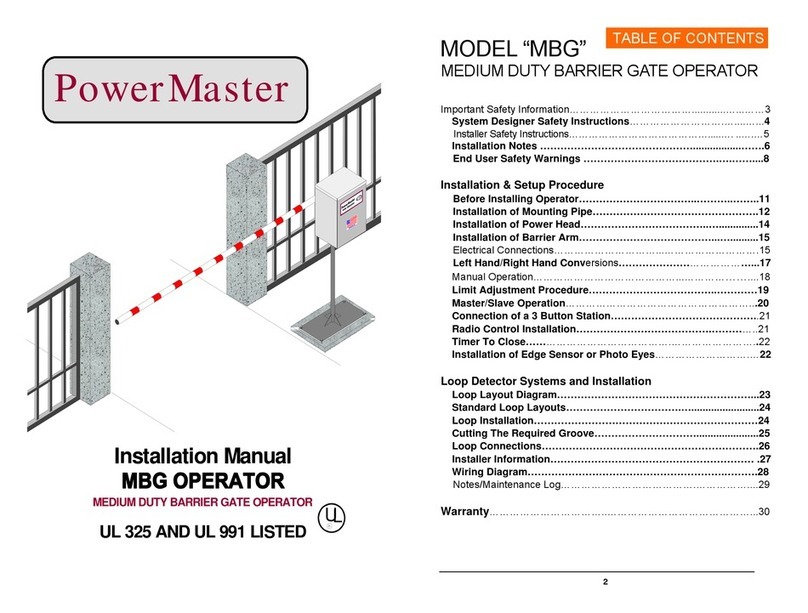
Power Master
Power Master MBG User manual
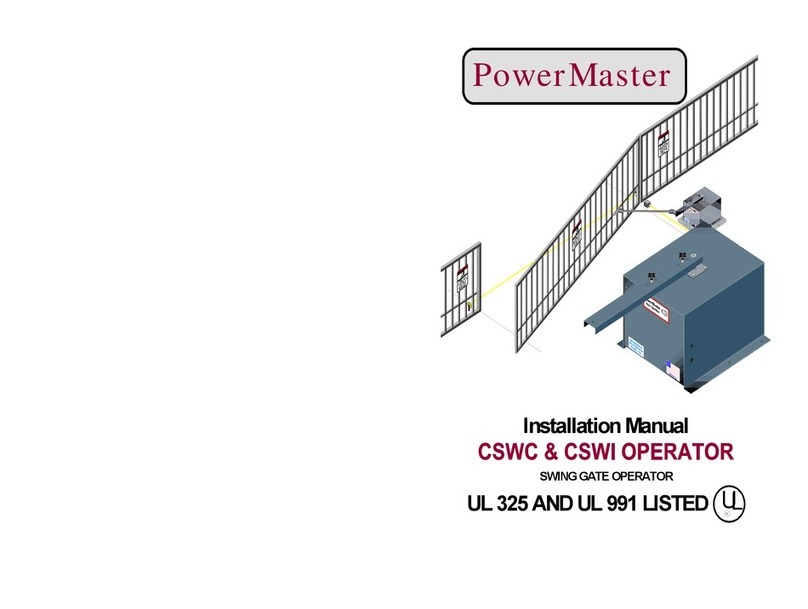
Power Master
Power Master CSWC User manual
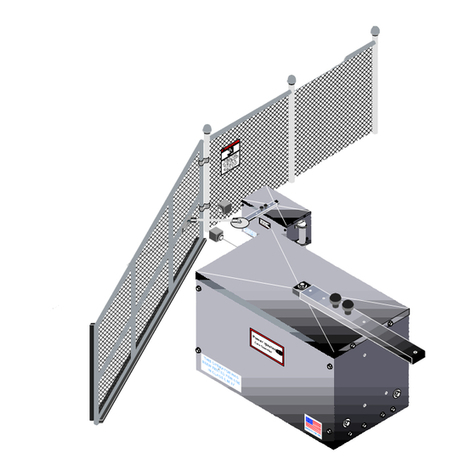
Power Master
Power Master rsw User manual
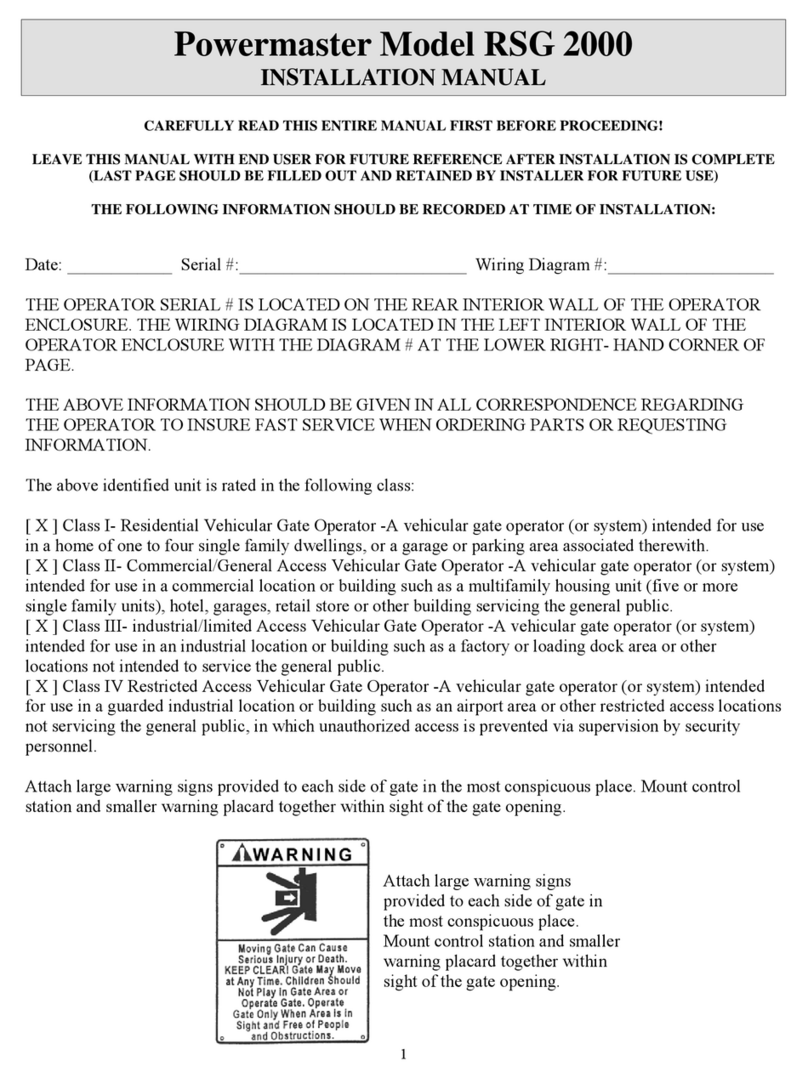
Power Master
Power Master RSG 2000 User manual
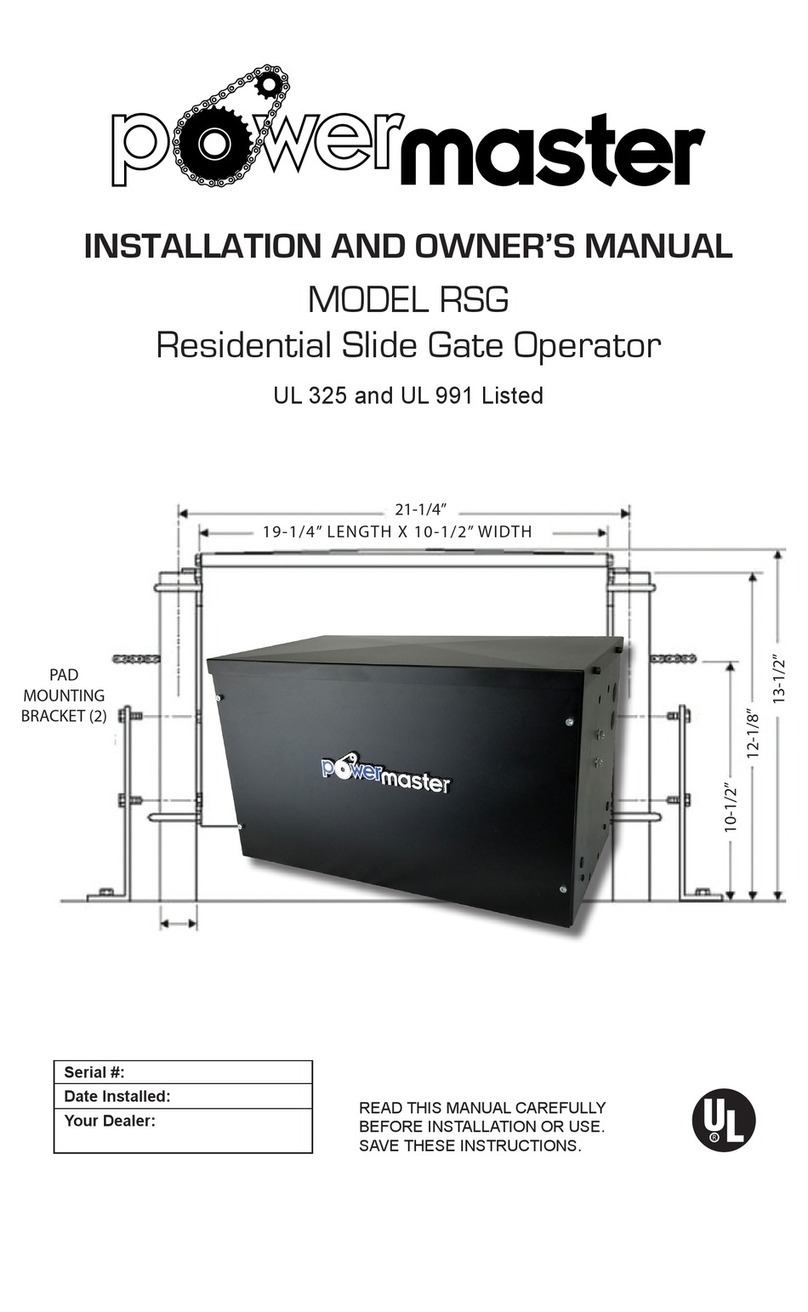
Power Master
Power Master RSG Installation instructions
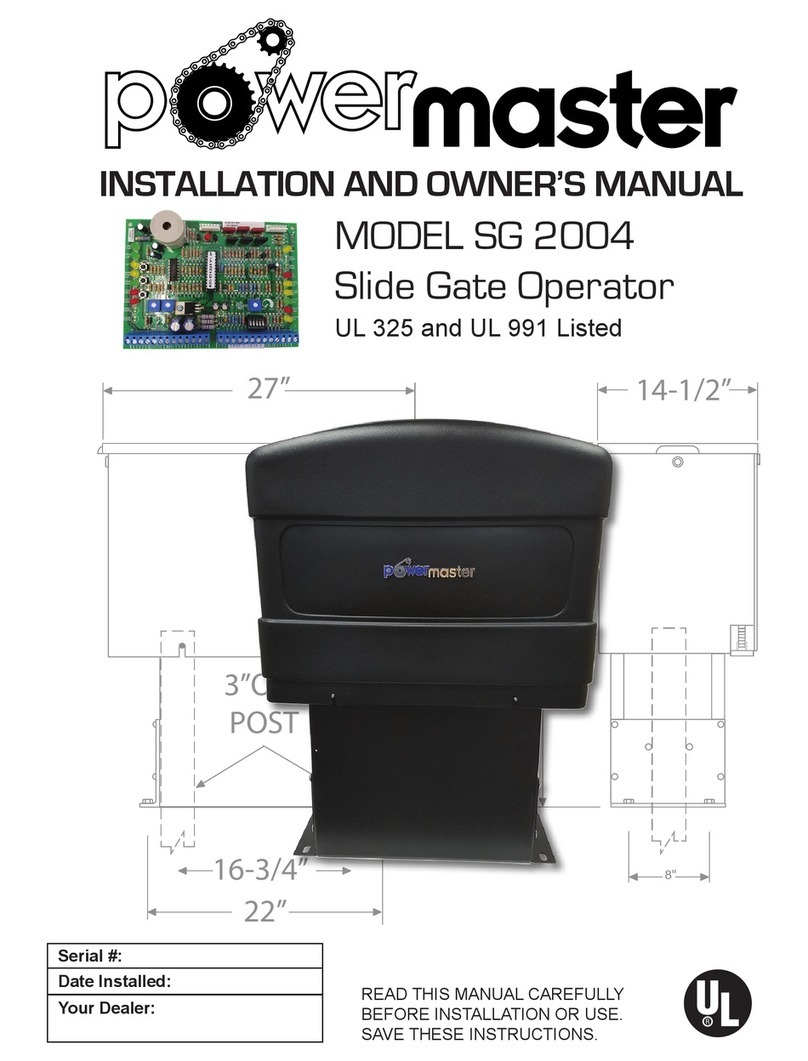
Power Master
Power Master SG 2004 Installation instructions
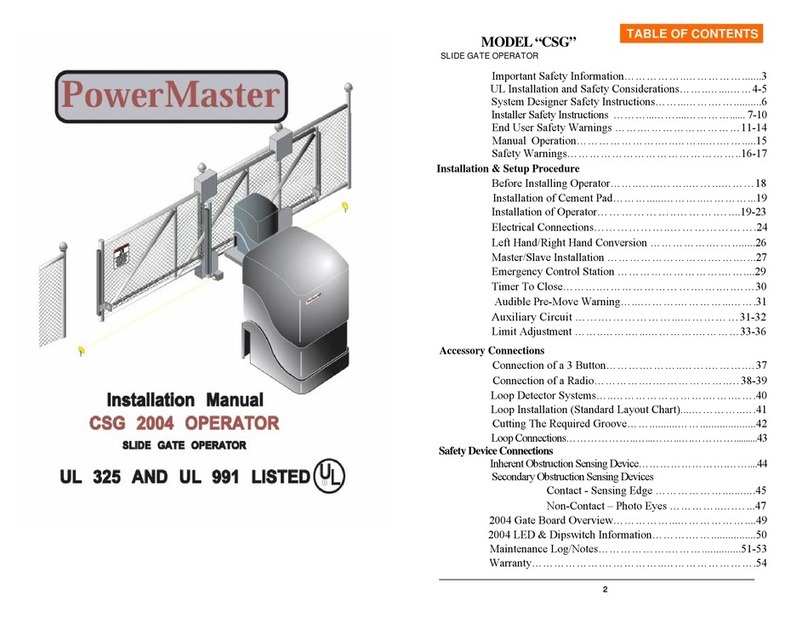
Power Master
Power Master CSG 2004 User manual
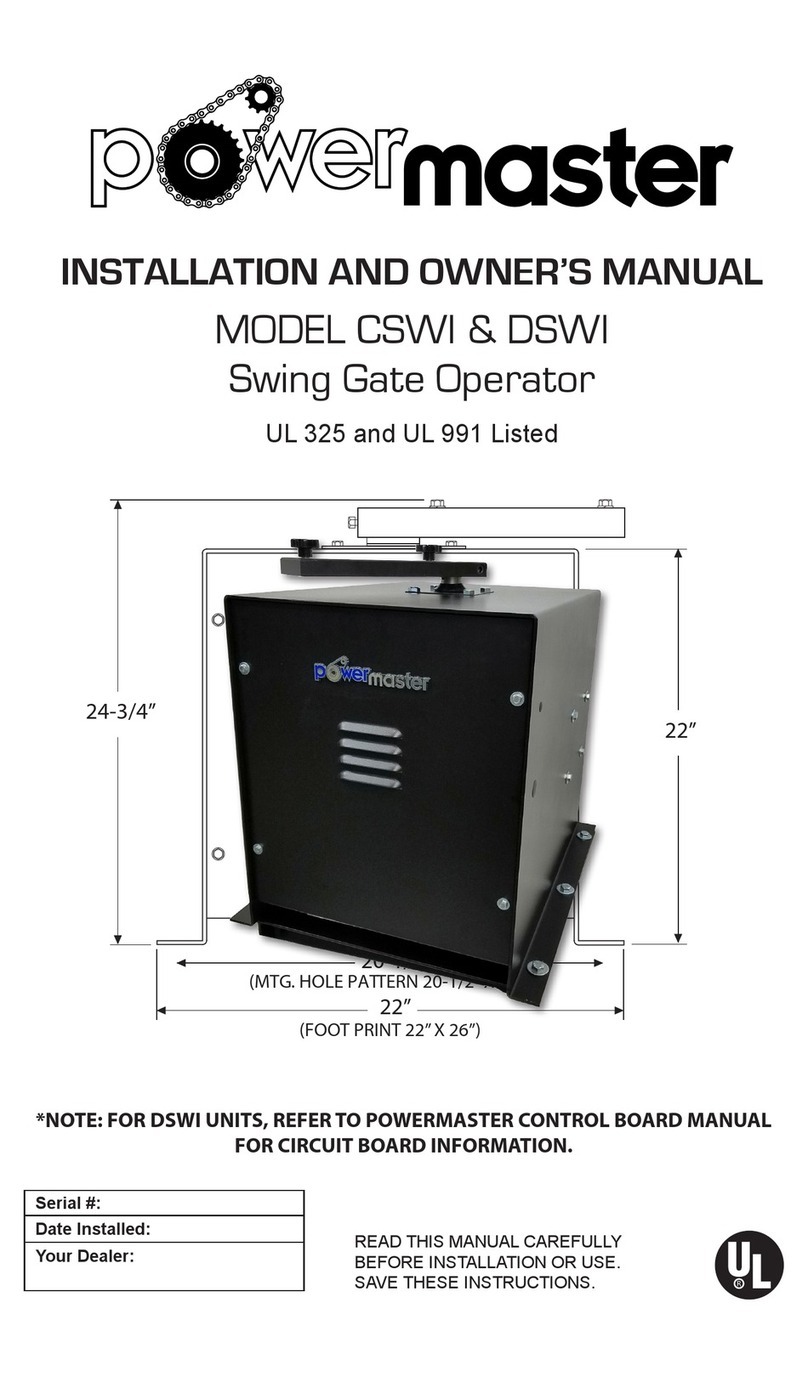
Power Master
Power Master DSWI Installation instructions
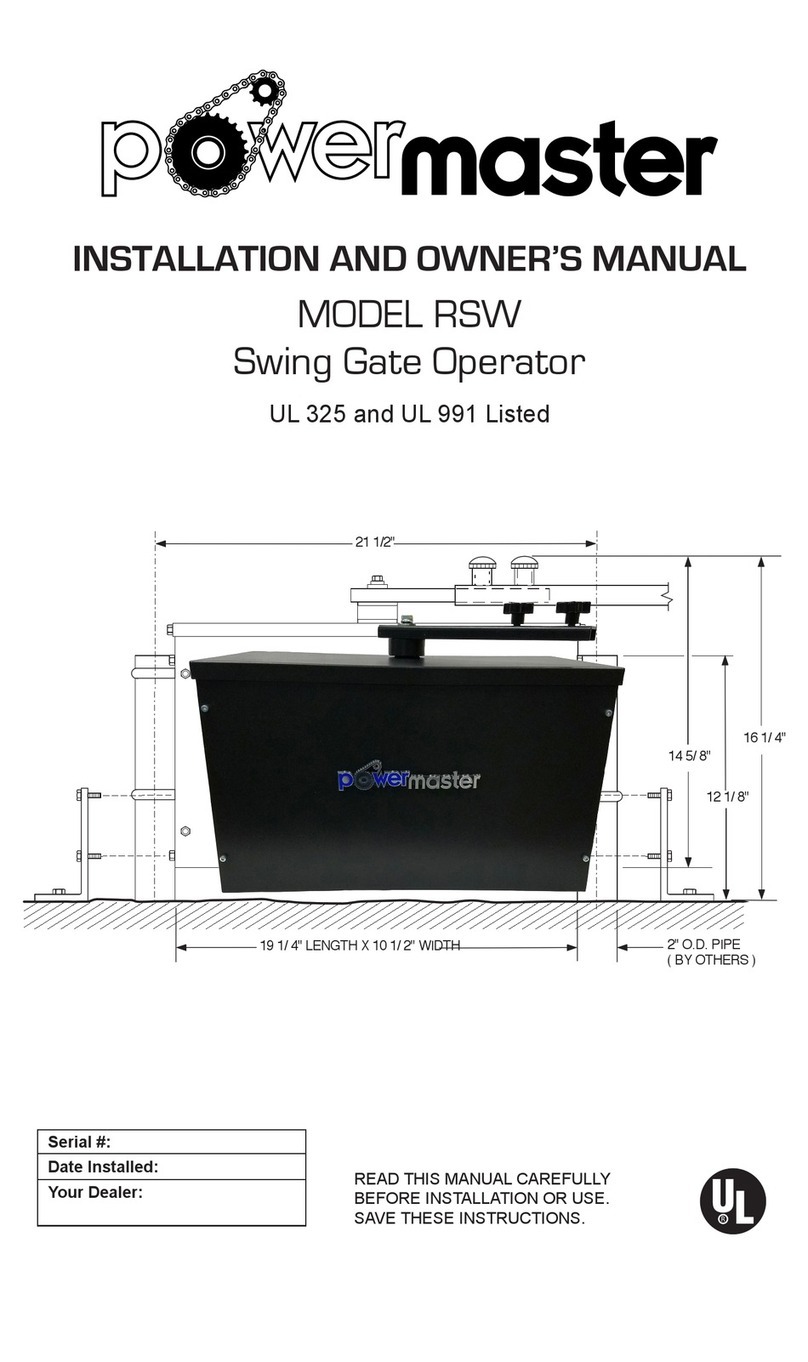
Power Master
Power Master rsw Installation instructions
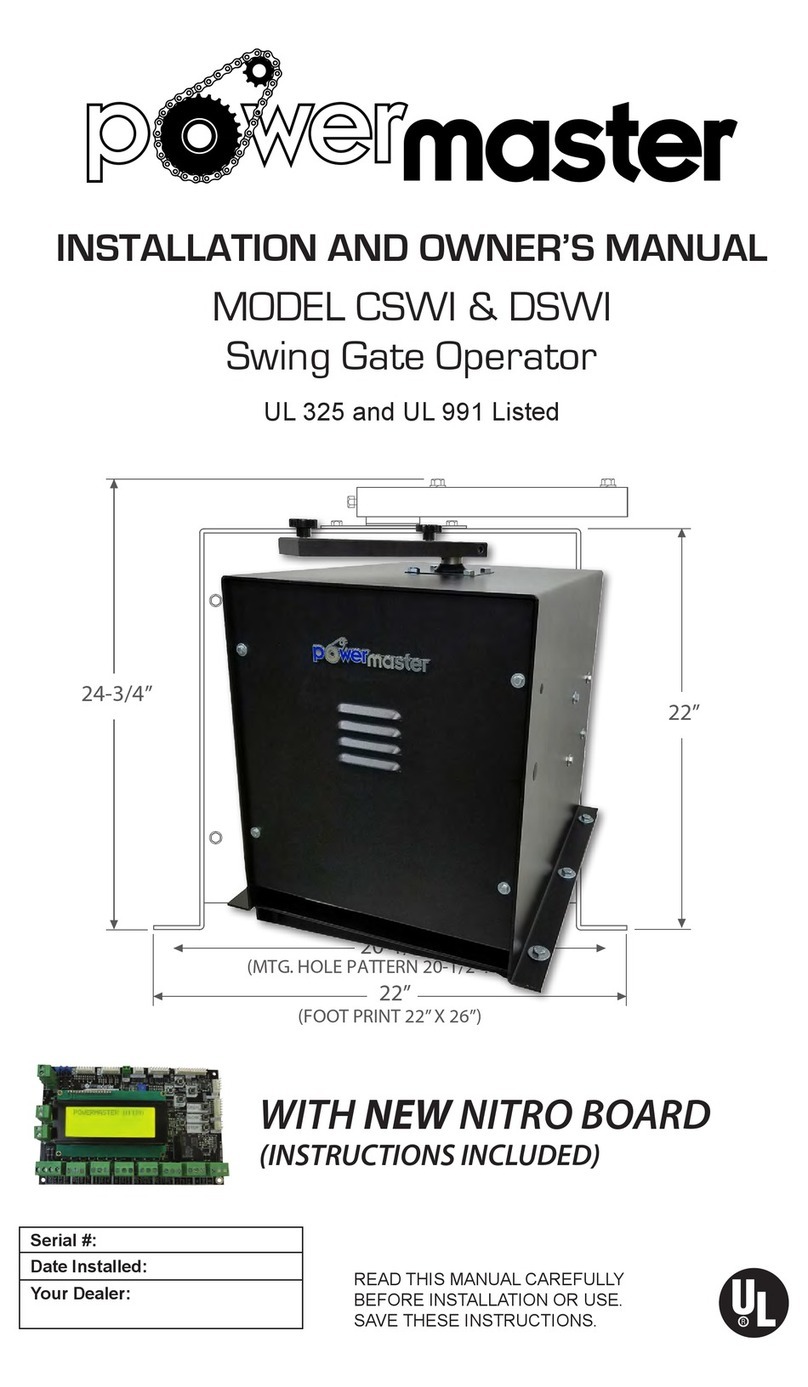
Power Master
Power Master CSWI Installation instructions
